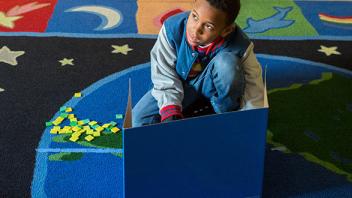The basics
Make the Classroom Sensory-Friendly Today
Learn simple ways you can make your classroom sensory-friendly to help students with sensory issues feel more comfortable and ready to focus on learning and socializing. Ideas include ways to adapt the classroom space, learning materials, lighting, noises, and smells.
Getting Comfortable in the Inclusive Classroom: Supporting Students with Autism
To create environments most conducive to learning for students with autism and their peers without disabilities, teachers may need to examine ways in which classroom spaces are organized. Specifically, teachers may need to consider the sounds, smells, lighting, and seating options in the classrooms.
Physical Structure in the School Setting
An organized classroom with defined areas and spaces can help students with autism in anticipating what is expected and to predict what will be happening during the instructional day. Get tips on how to create defined learning spaces and reduce distractions in your classroom.
Clean Up Your Act! Creating an Organized Classroom Environment for Students on the Spectrum
An organized classroom with defined areas and spaces can help students with autism in anticipating the requirements of a specific setting and to predict what will be happening during the instructional day. Get tips on how to organize your classroom.
Classroom Accommodations for Sensory Processing Issues
Students with sensory processing issues have trouble handling sensory input. And at school, they often have to cope with sounds, smells, textures, and other sensations that get in the way of learning. What classroom accommodations can help students with sensory processing issues? Here are some strategies teachers can try. (From Understood )
Sensory-Friendly Design Enters The Classroom
As more students with special needs enter school systems nationwide, educators are increasingly designing their classrooms to boost behavior and academic performance. Sensory-friendly design focuses on controlling the sights, sounds and smells that can be under- or overstimulating to students with autism or other developmental disabilities. A few schools have been built for this purpose, but any classroom can be retrofitted to improve its sensory environment, experts say.. (From Disability Scoop )
The Sensory Room: helping students with autism focus and learn
Imagine a safe space where students with autism can go to calm their bodies and then get back to the business of learning. Interested in learning how to create your own sensory room? Check out Sensory Room 101 . (Edutopia)
Q&A with occupational therapist Roger Ideishi
Occupational therapist Roger Ideishi shares his strategies for providing supportive environments in the general education classroom for children with autism. You’ll also learn about Ideishi’s innovative ideas for collaborating with museums, performing arts spaces, and other cultural institutions to make them more accessible and welcoming for children with diverse sensory and cognitive abilities. See Q&A
Sensory-friendly environments outside of school
Thanks to advocacy initiatives and a growing awareness of the needs of children with special sensory issues, municipalities, cultural organizations (museums, performing arts spaces), and other public places such as airports are adapting to be more sensory-friendly. These options can provide opportunities for rich learning and social experiences.
Sensory-friendly cultural experiences
Roger Ideishi, an occupational therapy professor, helps design sensory-friendly performances and cultural experiences so people with disabilities such as autism or sensory processing disorders can enjoy them.
Organizations with sensory-friendly programs
- The Smithsonian Institution: Resources for Visitors with Cognitive or Sensory Processing Disabilities
- The Kennedy Center: Sensory-Friendly Performance
- The Kennedy Center: Guidebook for Sensory Friendly Programming for People with Social and Cognitive Disabilities (PDF)
- Minnesota Orchestra: Sensory-Friendly and Relaxed Family Concerts
City programs with welcoming places for children with sensory issues
Autism-Friendly Tampa
Links to basic information about ASD, city programs, assistance and resources. See also: 8 sensory-friendly things to do in Tampa Bay for kids with autism
Sensory-friendly museum days in Philly
The mom of a young person with autism shares a round-up of the many museums featuring sensory-friendly days for families.
Kids And Adults With Autism Flying Easier In Pittsburgh, With Airport’s Help
Pittsburgh International Airport recently opened a suite of “sensory rooms” inside its airside terminal to help travelers on the autism spectrum decompress from the stress of flying.
